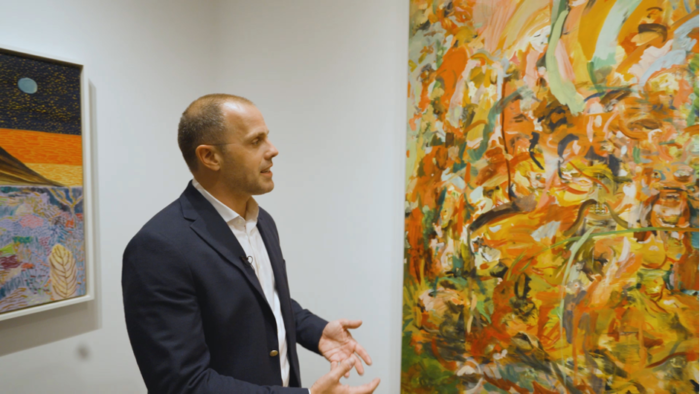
The fractional investment platform Masterworks is challenging the exclusive art world status quo once again. Their recently launched gallery, Level & Co., made history by opening the world’s first art exhibition to feature paintings owned entirely by the general public. Entitled “Into Another World,” the show opened on September 7, and it continues on an appointment-only basis through October 27.
Whereas gallery shows traditionally feature pieces on consignment from collectors, showcased by dealers themselves, or promoted by the artists themselves, in this case the collection on display consisted of paintings that had already completed investment rounds with the 800,000-strong user community of Masterworks.
Located in New York’s Upper East Side, Level & Co.’s “Into Another World” show displays works by big-name contemporary artists like Cecily Brown, Shara Hughes, and Matthew Wong.
For the first time, everyday investors have the chance to view, in-person, the multimillion-dollar paintings that they actually have a stake in – a concept that would have been relatively unimaginable just a few months ago. For Masterworks shareholders who are used to only viewing their own collections in virtual spaces, seeing these pieces in real life makes their involvement more experiential.

But “Into Another World” represents more than just investor access – it’s changing the way galleries operate.
For starters, displaying publicly owned paintings benefits both the investors and the artists. Investors finally get an up-close look at works they’ve funded while increased foot traffic boosts the chances these pieces will eventually be resold at wider profit margins to individual collectors. This has the potential to earn shareholders higher returns on their investments. For many, it will be their first chance to see a painting appreciate in value right before their eyes.
For the artists, having their work on display raises their public profile. Visitors who connect with one work are likely to explore more of that artist’s portfolio and become fans. Masterworks’ prospectuses provide deep dives into each creator’s background and influences, helping educate investors and build appreciative communities around the artists. There is no doubt that building name recognition among everyday art lovers, rather than just elite circles, has the potential to take an artist’s status to the next level.
On opening night, Level & Co. brought together an impressive roster of art industry leaders, connecting them with the exhibit’s crowd-funded investors. Their impassioned reactions are sure to spur greater demand for the featured artists while also signaling winds of change for the traditionally insular art world. All the chatter and hype from these influencers serves to bolster demand for the artists on display, as they return to their institutions with a new perspective.
It’s all part of Masterworks’ push to make the historically closed-off and elitist art world more transparent and human-focused. The company’s fractional ownership model already made blue chip art ownership more accessible for the non-elite. Now initiatives like Level & Co. are bringing art directly into public consciousness, rather than just the wealthy few.

Slowly but surely, the traditionally insular art finance landscape is shifting to be less exclusive. Art is being seen more and more as a creative achievement to be shared, rather than a status symbol. “Into Another World,” is empowering both investors and artists by dismantling some of the art world’s longest-standing barriers.
“We don’t represent artists, so we’re like a node in the art market where just works of art and capital is just churning through, and our objective is to try and expand the pool,” Evan Beard, an EVP of Masterworks who leads the management team at Level & Co., recently told USA Art News. “So this is the first gallery whose capital structure is really art owned by people from outside the art world, selling that art back into the art world.”
Masterworks’ incremental disruption is applaudable. While substantial progress remains, each step forward like this exhibition chips away at exclusivity. If art can be appreciated universally, not just by privileged circles, it may more profoundly uplift
